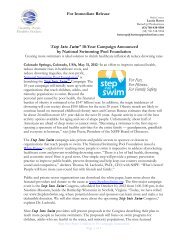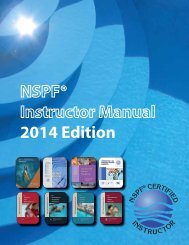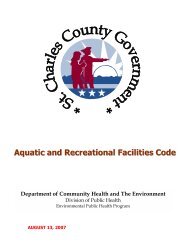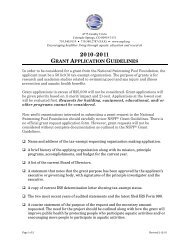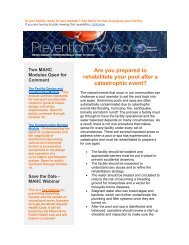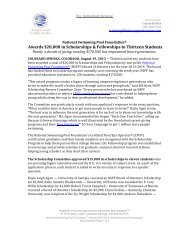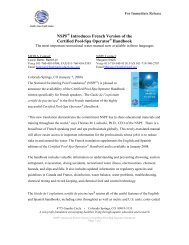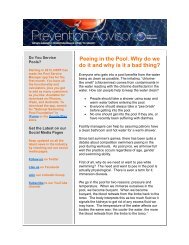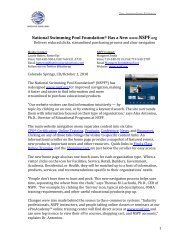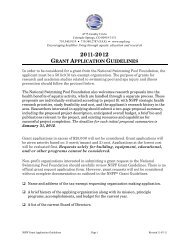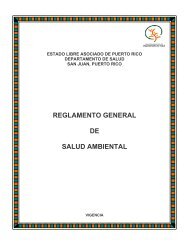English Instructor Manual (PDF) - Metric Version - National ...
English Instructor Manual (PDF) - Metric Version - National ...
English Instructor Manual (PDF) - Metric Version - National ...
Create successful ePaper yourself
Turn your PDF publications into a flip-book with our unique Google optimized e-Paper software.
Chapter 9 – Chemical Feed and Control<br />
Handbook: Pages 99-116<br />
Suggested Time:<br />
PowerPoint Slides:<br />
Materials:<br />
30 minutes<br />
Chapter 9 Slides<br />
Sample chemical feeder pump<br />
Objectives: At the end of this lesson, the student will be able to:<br />
1. List the methods by which chemicals can be added to pool/spa water<br />
2. Explain the difference between the various types of chemical feeders<br />
3. Explain the advantages of automated chemical feeders<br />
Leading Questions:<br />
What are several ways that chemicals can be added to the pool?<br />
What are the advantages and disadvantages of each?<br />
What are some safety precautions that should be observed when handling chemicals?<br />
Key Points: Discuss the various aspects of chemical feeders. These include:<br />
Chemical feeders provide effi cient addition of chemicals to water with minimal handling<br />
of the chemicals<br />
Common feeders include erosion (tablets), metering (liquid), or injection (gasses)<br />
Feeders can be manually operated or electronically controlled<br />
Feeders are a must for chemicals added on a daily basis, e.g. chlorines and acids<br />
Key Points: Discuss how to add chemicals to the water. Emphasize that, in most cases,<br />
chemicals should be added in small amounts over a long period of time. Exceptions include<br />
superchlorination and specialty chemicals, such as algaecides. Explain that feeding chemicals in<br />
the pool may be done in several ways. These include:<br />
Mechanical feeders. These include peristaltic, diaphragm, and piston pumps.<br />
Dry chemical feeders. These include erosion feeders and pressure-to-vacuum feeders.<br />
Gas feed systems. These include chlorine gas feeders and CO 2<br />
feeders.<br />
Ozone generators. These include corona discharge and ultraviolet ozonators.<br />
Chlorine generators. These include in-line generators and brine-bank generators.<br />
<strong>Manual</strong>ly. This includes manually over the main drain, manually into a skimmer, and<br />
broadcast directly across the pool<br />
Key Points: Discuss feeder automation. Include a brief discussion of:<br />
Advantages of automated control systems related to proportional feed feature and<br />
remote alarm options<br />
Types of chemical sensors: pH probes, ORP probes and amperometric probes<br />
Probe location and probe cleaning<br />
© 2014 <strong>National</strong> Swimming Pool Foundation® Page 69



